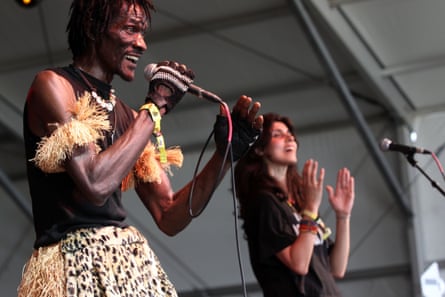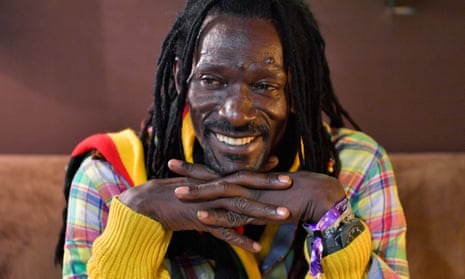By now the idea of a “musical revolutionary” has become so cliched that it can easily lose its meaning. But Janka Nabay is one artist for whom the phrase stands up. The Sierra Leonean musician has died aged 54, but he leaves a legacy as a bandleader and ethnomusicologist who not only kept his home country’s traditional bubu music alive by futureproofing it with dazzlingly Technicolor beats, but also brought the little-known sound to the world.
Nabay was a local star in Sierra Leone in the 1990s, during the country’s decade-long civil war. Bubu music, a style that originated from the Temne region, was until then only associated with old folk traditions; it was used in witchcraft ceremonies and later, with the arrival of Islam, in religious processions to mark the end of Ramadan. But Nabay modernised bubu by pairing its percussive bamboo cane flutes, wooden boxes and metal pipes (often made from repurposed parts of cars) with synthesisers and drum machines. He wanted his music to provide solace in war-torn Sierra Leone but also to establish a musical legacy for a country whose artists at the time were borrowing from reggae, hip-hop and R&B. “I’m the first guy who made it pleasant for people to come back to the culture, to love their culture,” he said in one interview.
His brightly lit electronic interpretation – which he said took inspiration from “Michael Jackson, Bob Marley and God” and was sung in a combination of his native Temne, English, Arabic and Sierra Leone’s common language, Krio – espoused messages of peace, good governance and female empowerment. It was both hypnotic and danceable, with fast, flickering, rhythmic lines that knotted together into something restlessly uplifting.
Nabay’s popularity, however, was a double-edged sword. His music was adopted by young rebel groups who, according to one biography, used “his tapes to sound their battle cry, blasting it out to the villages they invaded to lure people from their hiding spots”. At one point, they reportedly captured Nabay to make him perform for the troops and gear them up for battle.

When the civil war ended in 2002, Nabay fled to the US, where he worked in fast-food joints to make ends meet and unsuccessfully tried to start a band between shifts. Five years later, his old recordings were rediscovered by the journalist Wills Glasspiegel while sifting through a haul of cassettes that he’d received from the BBC. Nabay’s tape – made during his last night in Sierra Leone at Forensic Studios in Freetown – stood out and Glasspiegel tracked Nabay down to a fried-chicken shop in Philadelphia.
In Brooklyn, Nabay eventually found a group of like-minded musicians. He began playing at cult club Zebulon, which piqued the interest of various indie-experimentalists from the bands Skeletons, Chairlift, Highlife and Saadi. They became Nabay’s “Bubu Gang” and in 2010 released their first EP, Bubu King, which featured some of his last recordings in Freetown and is widely considered to be the first ever international bubu record. A debut album, En Yay Sah (which translates as I’m Scared), followed in 2012 on David Byrne’s Luaka Bop label and encapsulated the live shows he’d been playing with the gang at international festivals, a psychedelic trip that found acclaim with the indie music press.
Nabay’s last album, 2017’s Build Music, made his frenetically entangled beats more pronounced (not unlike South Africa’s Shangaan electro sound); his previous rockier freestyles with his hipster acolytes were swapped for housier, poppier beats, as on the tracks Santa Monica and Stop Jealous. The album also built on Nabay’s themes of migration and displacement. As a conflicted and apparently self-described “black cowboy” trying to make it as a musician in the US, he wanted to be a spokesperson for his traditional music while updating it for new audiences. He was hailed as an innovator but often risked being exoticised (an early photoshoot shows him looking uncomfortable in a traditional grass skirt and flamboyant crocheted top, operating a deep-fat fryer).
In many ways, Nabay’s trajectory feels familiar in today’s independent music circuit: Ata Kak, William Onyeabor and Hailu Mergia are all African artists who faded into obscurity only to be “rediscovered” by a boutique record label, their careers subsequently resuscitated for a largely western audience. But while Nabay’s story has a similar arc, his goal seemed to be not only to survive as an artist and give his home country a sound to be proud of, but also to inspire others to play it. He said in an interview last year: “I hope that people will concentrate on my music. I want to hear somebody in London play bubu music, somebody in Germany play bubu music. Somebody in South Africa, Nigeria, something like that. That’s my hope.”
Hope is one word that ricochets through those spirited Casio tones. Uncertain yet playful and optimistic, Nabay’s unique music deserves to live on now he has gone.

Comments (…)
Sign in or create your Guardian account to join the discussion